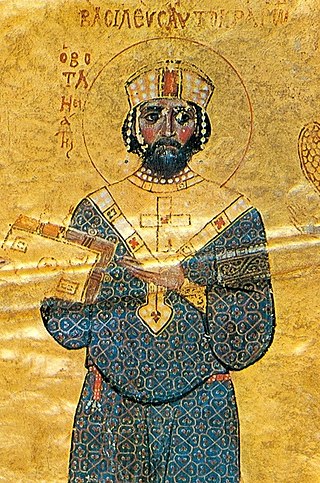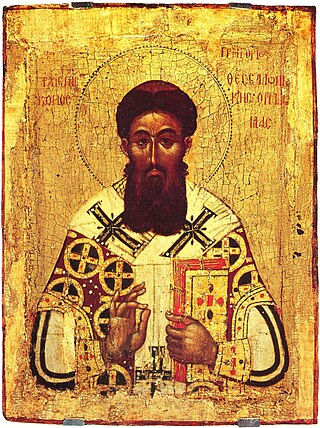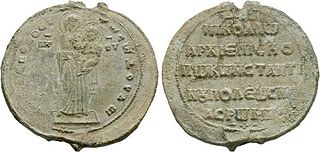
Nikephoros III Botaneiates, Latinized as Nicephorus III Botaniates, was Byzantine Emperor from 7 January 1078 to 1 April 1081. He was born in 1002, and became a general during the reign of Byzantine Emperor Constantine IX Monomachos, serving in the Pecheneg revolt of 1048–1053. His actions in guiding his forces away from the Pechenegs following the Battle of Zygos Pass, in which they suffered eleven days of harassment before finally reaching the Byzantine city of Adrianople, attracted the attention of fellow officers, and he received the title of magistros as a reward. Nikephoros served in the revolt of Isaac I Komnenos against the Byzantine Emperor Michael VI Bringas, leading forces at the decisive Battle of Petroe. Under the Emperor Constantine X Doukas he was made doux of Thessalonica. He later served as doux of Antioch. While doux of Antioch, he repelled numerous incursions from the Emirate of Aleppo. When Constantine X died in 1067, his wife, Empress Eudokia Makrembolitissa, considered taking Nikephoros as husband and emperor but instead chose Romanos IV Diogenes. The need for an immediate successor was made pressing by the constant Seljuk raids into Byzantine Anatolia, and Eudokia, Patriarch John VIII of Constantinople, and the Byzantine Senate agreed that their top priority was the defense of the empire and that they needed an emperor to lead troops to repel the Turks. Nikephoros was the favorite candidate of the senate, but was in the field leading troops in Antioch and was still married. Romanos, once chosen to be emperor, exiled Nikephoros to his holdings in the Anatolic Theme, where he remained until he was brought out of retirement by the Emperor Michael VII and made kouropalates and governor of the Anatolic Theme.

Gregory Palamas was a Byzantine Greek theologian and Eastern Orthodox cleric of the late Byzantine period. A monk of Mount Athos and later archbishop of Thessalonica, he is famous for his defense of hesychast spirituality, the uncreated character of the light of the Transfiguration, and the distinction between God's essence and energies. His teaching unfolded over the course of three major controversies, (1) with the Italo-Greek Barlaam between 1336 and 1341, (2) with the monk Gregory Akindynos between 1341 and 1347, and (3) with the philosopher Gregoras, from 1348 to 1355. His theological contributions are sometimes referred to as Palamism, and his followers as Palamites.

The Hilandar Monastery is one of the twenty Eastern Orthodox monasteries in Mount Athos in Greece and the only Serbian Orthodox monastery there.

The Sacred Patriarchal and Stauropegic Monastery Esphigmenou is an Eastern Orthodox monastery dedicated to the Ascension of Christ in the monastic state of Mount Athos in Greece. It is built next to the sea at the northern part of the Athonite peninsula. Located near the Hilandar monastery, it is the northernmost of all Athonite monasteries.

Alexios III Megas Komnenos, or Alexius III, was Emperor of Trebizond from December 1349 until his death. He is perhaps the best-documented ruler of that country, and his reign is distinguished by a number of religious grants and literary creations.
Philotheos Kokkinos was the Ecumenical Patriarch of Constantinople for two periods from November 1353 to 1354 and 1364 to 1376, and a leader of the Byzantine monastic and religious revival in the 14th century. His numerous theological, liturgical, and canonical works received wide circulation not only in Byzantium but throughout the Slavic Orthodox world.
Kallistos I was the Ecumenical Patriarch of Constantinople for two periods from June 1350 to 1353 and from 1354 to 1363. Kallistos I was an Athonite monk and supporter of Gregory Palamas. He died in Constantinople in 1363.

Dionysiou Monastery is an Eastern Orthodox monastery at the monastic state of Mount Athos in Greece, at the southwest part of the Athos peninsula. The monastery ranks fifth in the hierarchy of the Athonite monasteries. It is one of the twenty self-governing monasteries in Athos, and it was dedicated to John the Baptist.

Xenophontos Monastery is an Orthodox Christian monastery in the monastic state of Mount Athos in Greece.

George the Hagiorite was a Georgian monk, calligrapher, religious writer, theologian, and translator, who spearheaded the activities of Georgian monastic communities in the Byzantine Empire. His epithets Mt'ats'mindeli and At'oneli, meaning "of the Holy Mountain" (Hagiorite) and "of Athos" respectively, are a reference to his association with the Iviron monastery on Mount Athos, where he served as hegumen.

John XIV, surnamed Kalekas, was the Ecumenical Patriarch of Constantinople from 1334 to 1347. He was an anti-hesychast and opponent of Gregory Palamas. He was an active participant in the Byzantine civil war of 1341–1347 as a member of the regency for John V Palaiologos, against John VI Kantakouzenos.
Eustratius Garidas was Ecumenical Patriarch of Constantinople between 1081 and 1084. A monk, he was elevated to the patriarchal throne through the influence of the mother of the emperor Alexios I, Anna Dalassene, to whom he had become an intimate advisor. He was an eunuch.
Basil I, surnamed Scamandrenus or Skamandrenos, from the Skamandros Monastery, which he founded, was Ecumenical Patriarch of Constantinople from 970 to 974. Before his election as Patriarch, he was a monk in Olympus of Syria and continued his monastic life after his election. As a Patriarch, he was accused as a conspirator against the Emperor John I Tzimiskes and as a violator of holy rules, but he refused to appear in front of a royal court. He was exiled and went to the Skamandros Monastery, where he died.

Nicholas II Chrysoberges was Ecumenical Patriarch of Constantinople from 984 to 991.
John IX Agapetos or Hieromnemon was Ecumenical Patriarch of Constantinople between 1111 and 1134. John's nickname is because before his election to the Patriarchal throne he held the office of hieromnemon within the Patriarchate. He was the nephew of a prominent Metropolitan of Chalcedon.
Maximus IV, previously known as Manasses (Μανασσῆς), was an Orthodox Christian monk and bishop. He was Ecumenical Patriarch of Constantinople from 1491 to 1497.

Saint Sava, known as the Enlightener, was a Serbian prince and Orthodox monk, the first Archbishop of the autocephalous Serbian Church, the founder of Serbian law, and a diplomat. Sava, born as Rastko Nemanjić, was the youngest son of Serbian Grand Prince Stefan Nemanja, and ruled the appanage of Zachlumia briefly in 1190–92. He then left for Mount Athos, where he became a monk with the name Sava (Sabbas). At Athos he established the monastery of Hilandar, which became one of the most important cultural and religious centres of the Serbian people. In 1219 the Patriarchate exiled in Nicea recognized him as the first Serbian Archbishop, and in the same year he authored the oldest known constitution of Serbia, the Zakonopravilo nomocanon, thus securing full religious and political independence. Sava is regarded as the founder of Serbian medieval literature.
This is a timeline of the presence of Eastern Orthodoxy in Greece from 717 to 1204. The history of Greece traditionally encompasses the study of the Greek people, the areas they ruled historically, as well as the territory now composing the modern state of Greece.
This is a timeline of the presence of Eastern Orthodoxy in Greece from 1204 to 1453. The history of Greece traditionally encompasses the study of the Greek people, the areas they ruled historically, as well as the territory now composing the modern state of Greece.

The monastic community of Mount Athos is an Eastern Orthodox community of monks in Greece who hold the status of an autonomous region with its own sovereignty within Greece and the European Union, as well as the combined rights of a decentralized administration, a region and a municipality, with a territory encompassing the distal part of the Athos peninsula including Mount Athos. The bordering proximal part of the peninsula belongs to the regular Aristotelis community in Central Macedonia.











